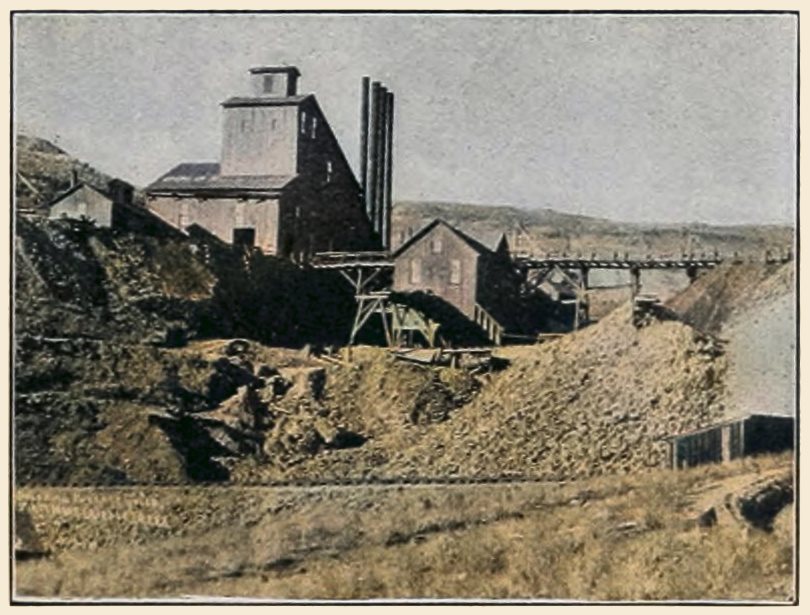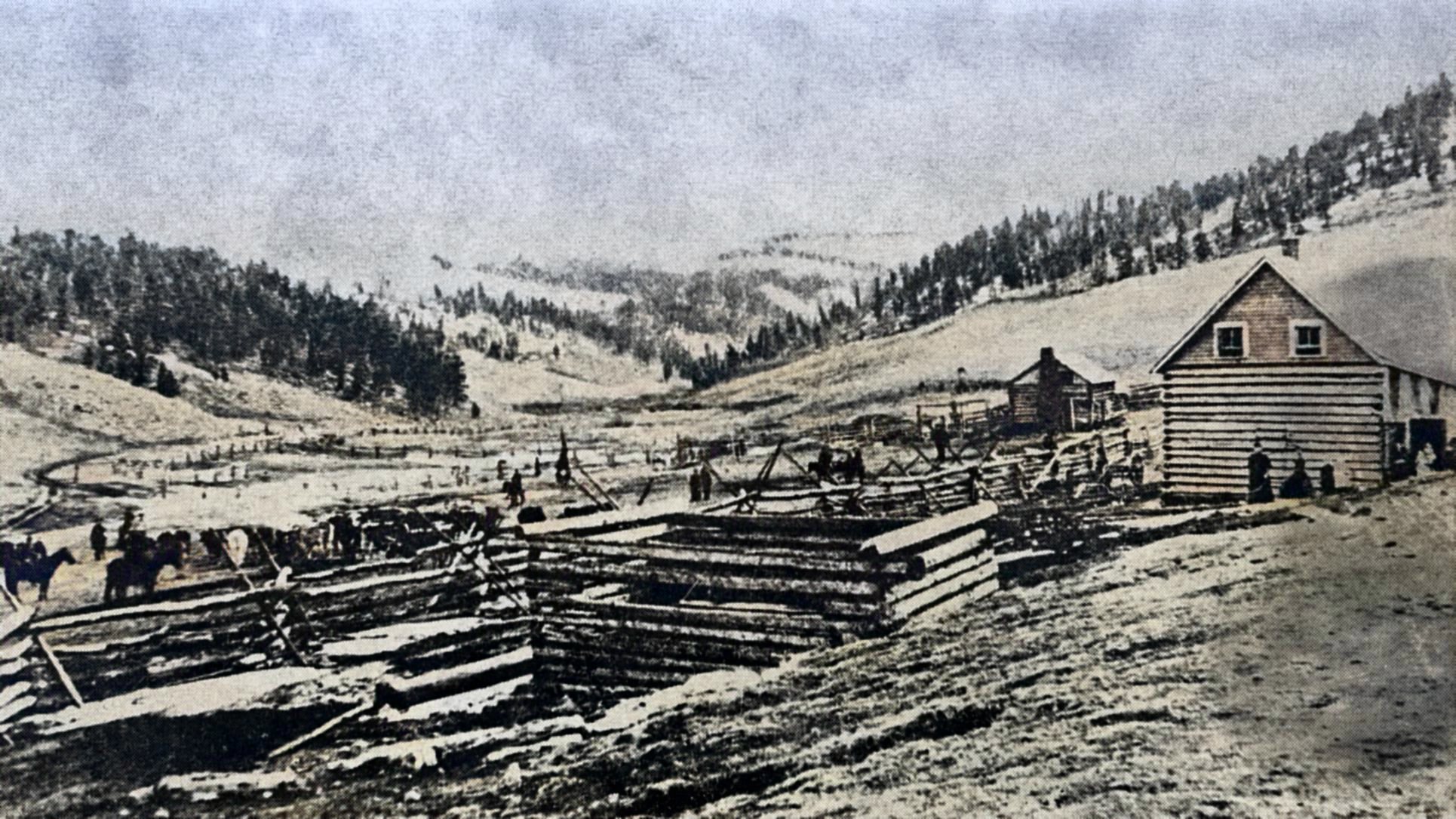-> My Collection, Also on
-> the Internet Archive Site; Link to article.
New Year Edition 1903
(page 55)
I added 1 image from my collection, and procured the coloring of the images, source paper had only pic of the man himself
To the persistency and pluck of an humble prospector is due the fact that the world has been enriched by many millions of golden treasure.
Laughed at as a visionary, regarded by some as being weak-minded because of his ceaseless search through the hills of the Cripple Creek region for the gold which he declared existed there, Bob Womack, the discoverer of Cripple Creek, never rested until his mission was accomplished and the great gold camp had been given to the world.
Robert Womack was born in Kentucky 54 years ago. He was of sturdy Irish-American stock, the kind that peoples wildernesses and discovers hidden treasure. Of the blood of Daniel Boone, it was but natural that the Womacks should be found upon the borders of civilization.
The Womacks, father and son, came to Colorado in 1872, and located a cattle ranch about 15 miles north of Pueblo. Robert, for several years after coming to Colorado, worked as a cowboy in the employ of his father.
In 1876 father and son came to the Cripple Creek region, and purchased the Welty homestead, which covered what is now the townsite of Cripple Creek.
As time progressed Womack acquired other lands, notably the Requa townsite and the ground in the vicinity of Mount Pisgah, which were added to the ranch, known as the Broken Box ranch.
Along in 1886 the Womacks, who had mortgaged the ranch to Bennett & Myers, found that they were unable to even pay the interest and the Denver firm foreclosed, and the elder Womack returned to the ranch near Colorado Springs.
Bob had always been impressed with the idea that the hills surrounding Cripple Creek contained gold in paying quantities, and in 1878 he started out upon his quest. His first location was the El Paso Gold King. He took some of the rock to Colorado Springs, where it was assayed, showing considerable richness.
Notwithstanding the good showing made, Bob neglected to perform the necessary work upon the claim and it was jumped. The new locators failed to work their assessments, and Womack again located the property.Notwithstanding the good showing made, Bob neglected to perform the necessary work upon the claim and it was jumped. The new locators failed to work their assessments, and Womack again located the property.
The Gold King had been jumped three different times and during its history had borne several different names before it became celebrated as the El Paso Gold King.
During the years '90 and '91 Womack had between thirty and forty locations in the camp. Generous to a fault, whenever one of his friends was looking for a location, Bob would present them with a claim, and thus it came to pass that some of the best properties in the district passed through his hands without his having received the slightest benefit therefrom.
Among the properties upon the claims which the generous prospector gave away were such as;
the Kittie M.
the Lone Star
the Abe Lincoln
the C. O. D.
the Rebecca,
and dozens of others on Bull hill and Battle mountain.
Just previous to the rush of 1891 a fake story of the discovery of gold at Florissant was published in the Denver papers and prospectors flocked thither, Womack among the number.
At that point Womack managed to persuade a party, among the members of which were Joe Hanbury, Frank Costello and P. J. Ryan, to come to Cripple Creek. This party located the;
and other north-end properties.
Samples from these claims were assayed at Colorado Springs and Denver, and the results caused the rush of 1891 to the district.
Womack, after the loss of the Broken Box ranch, still continued to make it his home, performing all sort of work to pay for his board, while he spent his days in the hills, prospecting for the yellow metal.
He was regarded as considerable of a nuisance by Manager Carr of the ranch, who believed that he was weak-minded upon the subject of gold. Mr. Carr reported to Myers that every hole sunk by Womack meant the loss of a steer.
When Mr. Myers visited the ranch he and Carr went to where Womack was at work, up Poverty gulch, at what is now the Gold King, and, calling Bob from the hole, Myers told him that he would have to leave the ranch.
Bob denied that his prospects had caused the loss of any cattle, and before the proprietor of the ranch left the prospector had partially converted him to his own opinion of the possibilities of the region, and Myers took with him to Denver a sack of rock from the Gold King.
Whether the Denver assayer who received the rock had contemptuously thrown it into the alley, or whether his tests were not of the proper sort, may never be known, but the fact remains that he failed to report a single, trace in what afterward turned out to be the richest ore ever found upon the American continent, and Myers was deprived of the opportunity of a lifetime.
However, Bob Womack made him exceedingly rich after all, for the despised ranch of the Womacks became the Cripple Creek townsite, the sale of which, according to Mr. Myers' own statement, netted the firm of Bennett & Myers a large fortune.
Bob Womack sold the El Paso Gold King claim for $300, and the purchaser a little later sold a third interest for $35,000. Today the property could not be purchased for many thousands of dollars. It has already made several men rich.
Bob Womack today lives in Colorado Springs, and assists a spinster sister in running a boarding house and in taking care of their father, who is nearly ninety years old.
The last visit of the discoverer of Cripple Creek to the camp was on Fourth of July, when the pioneers of the district vied with each other in showing him honor.



